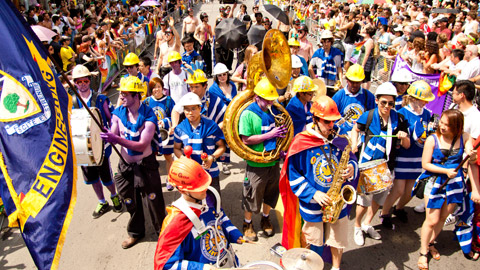Four students who will be joining U of T Engineering this fall are lauded in the Toronto Star and York Region for their academic and personal accomplishments.
Find out more about the stellar students below:
Shums Kassam, 18
The Markham student, who is currently volunteering at an orphanage in Tanzania, was the president of his school’s social justice club and a member of the dragon boat team that travelled to Macau last year for an international sport competition.
The Roberts High School student, who spends his free time tutoring youth, graduated with 100% in calculus, functions, two chemistry courses and physics.
Harris Chan, 18
The high school graduate, who is colourblind, has experienced increased attention in past years for his ability to solve the Rubik’s Cube in less than 10 seconds.
Mr. Chan graduated with 100% in functions, calculus, two chemistry courses, and 99% in physics and economics.
Tommy Pearson, 20
The soon-to-be engineering student spends his free time volunteering as a math tutor and part-time hockey coach in his local community.
As a continuing education student Pearson has worked hard to accomplish his enviable grade point average of 100% in calculus, physics, functions, economics; 98% in chemistry and 96% in English.
Ashley Deonarain, 17
In addition, Ashley Deonarain, who was valedictorian of her graduating class, will also join U of T Engineering this fall.
The youth currently spends her free time volunteering for a variety of causes. In the past, she was an athletic council executive, swim instructor and LINK crew leader (helping Grade 9 students to adjust to high school).
Ms. Deonarain graduated with 100% in two biology classes, two math courses, chemistry and economics.
They are four of the many outstanding students attending U of T Engineering after an unprecedented 2010-11 admission cycle.

Engineering students at the University of Toronto have won the Special Judges’ Award for Shock and Awe at the 2011 Toronto Pride Parade, the city’s annual celebration of the lesbian, gay, bisexual and transgendered communities.
The contingent was organized by the Engineering Society, the student government for undergraduate students in the Faculty of Applied Science & Engineering. The Engineering Society has participated in the Pride Parade for a number of years, with the Cannon Guard, which fires and protects the Skule™ Cannon, and the Lady Godiva Memorial Band both on hand.
Deciding to one-up themselves, students constructed a float for this year’s parade that featured a large silver horse. The float was constructed by the Blue and Gold Committee, the Engineering Society’s spirit committee, and was the brainchild of co-chairs Luis Ramirez (ECE 1T2+PEY) and Sandra Sousa (ECE 1T3).
“Because Pride is such a huge event in Toronto, we felt that U of T Engineering should have more of a presence. Plus, we like to show off our skills,” explains Sousa.
The Blue and Gold Committee already constructed two floats each year; one for the annual orientation parade and the other for homecoming. Ramirez explains that part of the reason the Pride Parade became the focus for a third float was to combat the impression that engineering is not an inclusive profession.
“Engineering is typecast …” Ramirez says, adding, “we want to show that engineering is accepting and supporting of everyone.”

Ramirez explains that the horse was in honour of Lady Godiva, who is famed for her nude ride through the streets of Coventry, England.
“Our patron saint is Lady Godiva, so it was meant to represent Godiva’s horse,” he says.
Despite careful planning and diligent construction, the U of T group did face one big challenge prior to the start of the parade: the horse broke into four different pieces en route to the marshalling area.
“We had to call in all sorts of reinforcements, but we ended up putting it back together,” explains Sousa, noting that duct tape and some borrowed tools helped to ensure the float was roadworthy in time for the parade’s start. Plus, more than 50 students were on hand to help out.
“Pride Toronto would like to congratulate the University of Toronto Engineering students for their inspiring collective efforts and colourful spirit in this year’s Pride parade,” states Peter McHugh, Communications Director for Pride Toronto.
When asked to explain what they did to earn an award called “shock and awe,” Ramirez suggests the Skule™ Cannon may have played a role.
“We fired the cannon right in front of the judges, which I think was the shock part,” he says.
“I guess the coveralls and the hard hats were pretty shocking. You don’t normally see that sort of thing at the Pride Parade,” offers Sousa.
While the judges were shocked and awed by the cannon, they have been invited to return next year.
“Pride Toronto welcomes the participation of University of Toronto Engineering students and other engineering groups in future Pride Toronto celebrations,” says McHugh.
Sousa and Ramirez think the award will help ensure that Pride Parade float becomes an annual tradition.
“The reason we built a float this year is because we want this to be the start of a new tradition,” Ramirez explains.
The focus now for the Blue and Gold Committee is on constructing this year’s orientation float.
“As engineers, we always try to outdo ourselves,” says Ramirez. “We want to make sure that not just the Engineering frosh know about us, but the campus knows about us.”
The orientation parade will take place on September 9 beginning at 2 pm on Front Campus.
University of Toronto researchers will benefit from a $19.58 million investment in water technologies announced today by FedDev Ontario, an agency created in 2009 as part of Canada’s Economic Action Plan.
Peter Kent, Canada’s minister of environment, was on campus to announce funding to the Southern Ontario Water Consortium, an alliance of universities, companies, municipalities and non-profit organizations working to develop, test and pilot water technologies.
U of T researchers participating in the Southern Ontario Water Consortium include:
- Robert Andrews, Susan Andrews and Ron Hofmann of civil engineering, who comprise the Drinking Water Research Group;
- Vanessa Allen of laboratory medicine and pathobiology;
- Miriam Diamond of geography and chemical engineering and applied chemistry;
- Eric Miller of civil engineering; and,
- Brent Sleep of civil engineering.
The funding will allow the Southern Ontario Water Consortium to build an integrated system for the development, testing and demonstration of new market-driven water technologies and services, primarily along the Grand River and adjacent watersheds.
“Our government is committed to supporting innovative projects, to ensure that businesses and communities in Southern Ontario can continue to grow now and in the future,” said Gary Goodyear, Canada’s Minister of State for the Federal Economic Development Agency of Southern Ontario, who made a simultaneous announcement of the project at the 2011 Association of Municipalities of Ontario annual conference. He noted that the project was also expected to create jobs throughout the region.
“The quality, safety and viability of water is one of the vital issues facing global society today,” said Professor Peter Lewis, U of T’s Associate Vice-President (Research). “U of T is proud to be collaborating with so many other organizations to ensure that people in Southern Ontario and around the world continue to enjoy access to safe, clean water. Thank you to the Government of Canada for their investment in this important work.”
The Engineering Student Outreach Office (ESOO) in the Faculty of Applied Science & Engineering will benefit from two new grants announced by governments in Canada.
On August 17, the Federal Economic Development Agency for Southern Ontario announced a grant of $1.25-million to support Actua, a national science, engineering and technology youth outreach network. These funds will support outreach programs at nine universities in Southern Ontario, including ESOO, that target Aboriginal youth, girls and at-risk youth.
“This additional funding will allow us to continue to increase our innovative programming,” explains Dawn Britton, ESOO’s Associate Director.
In addition, ESOO’s Da Vinci Engineering Enrichment Program (DEEP) has been selected as one of three possible destinations for students in Newfoundland and Labrador who receive a new award.
The Newfoundland government, through the Research & Development Corporation, established the Research Inspired Student Enrichment (RISE) Awards on August 23. The award provides top high school students with the chance to attend internationally recognized science and technology enrichment programs for youth.
DEEP provides high school students who have a keen interest in engineering with the chance to gain hands-on experience in a number of specialized fields. The program is offered each year in July. More than 4,000 students have participated in the program since it was established in 2003. Courses are taught by some of the Faculty’s top graduate students.
The other two destinations are Shad International, which hosts programs at ten different universities in Canada, and the Research Science Institution, which is based at the Massachusetts Institute of Technology (MIT).
“These new awards will support our effort to recruit students to DEEP from coast to coast,” says Britton, noting that only one student from Newfoundland previously attended DEEP.
The first RISE Awards will be presented in 2012.
In a series of recent reports, Professor Doug Perovic (MSE), discusses possible explanations for recent “glass bombs” that have left pedestrians in the city of Toronto scrambling for cover.
The U of T engineer said it will take at least several weeks to determine the cause of the exploding glass that keeps falling from residential buildings. But circumstantial evidence points to faulty glass rather than improper installation.
“If it was bad installation, this would only happen on a really hot day, which (Monday) wasn’t,” Perovic said. “And with it happening throughout the city with different railing systems, it is likely bad glass.”
To read more of Professor Perovic’s comments please visit the Toronto Star , Globe and Mail , CityTV , Global TV, or CBC News.
University Professor Michael Sefton (ChemE 7T1) provides expert comment on an engineering breakthrough developed by MIT researchers that could possibly lead to better drug delivery and artificial tissues that imitate natural tissue.
“The method is quite creative,” said Sefton who teaches in the Department of Chemical Engineering & Applied Chemistry (ChemE) and the Institute of Biomaterials & Biomedical Engineering (IBBME). “It offers the opportunity to make multilayer microstructures. The next step is figuring out what you can do with these two-layer structures.”
To read the full story, please visit MIT News or NanoWerk.
